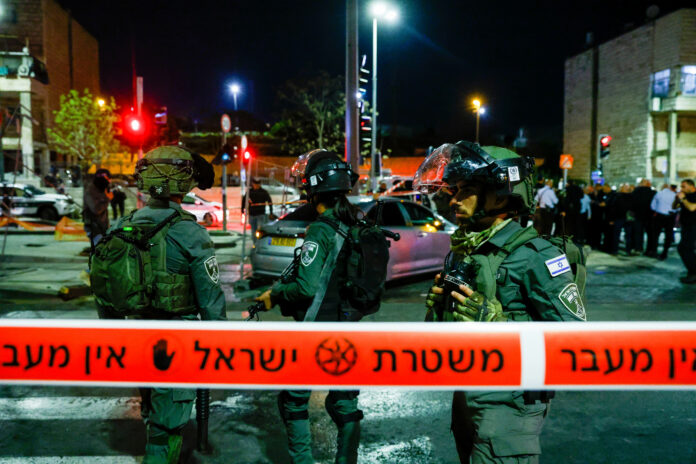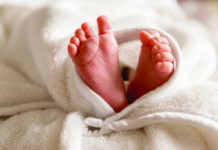
Shimon Yisrael was sitting at the Shabbos table with his wife, Yochi, and his daughter Ronit on the first floor of their home in Neve Yaakov, when they heard gunshots. At first, he assumed it was nothing serious. “It must be from Shuafat [a nearby Arab neighborhood]. They’re always shooting there at night. It’s probably a wedding or some other celebration.” But the sounds were too close.
He opened the shutters and saw people running. His daughter said, “Abba, don’t go out!” But he did. His upstairs neighbor, Eli Mizrachi, was running outside. “I said to him, ‘Eli, where are you running?’” Shimon recounted. “He told me to call the police because there had been a shooting. Moments later, I saw a gruesome sight in the light of the street lamps.”
In the middle of the street, a young Arab was standing with a gun in his hand. At his feet were bleeding victims—including Eli Mizrachi.
As Shimon stood there, the terrorist turned and pointed the gun at him. In that split second, he realized that his life was in danger. He threw himself to the ground as a bullet whizzed past his head, shattering his kitchen window. Shimon crawled back inside his house as fast as he could, trembling in fear. He locked the door behind him.
Then he called the police. He told his wife and daughter what he had seen, and the three of them waited in terror as the gunshots and cries of the wounded continued outside. At one point, they heard someone pleading, “Please, don’t shoot me!” The only answer was gunfire. After several long moments of insanity, the sounds of gunfire stopped, and quiet suddenly descended, to be quickly replaced by the wails of police sirens and ambulances. Only then did Shimon dare to leave his home and go back outside.
The attack that shocked the neighborhood—and the entire country—was one of the worst terrorist attacks in Israel’s recent history, with seven victims, Hy”d. How did it happen?
Neve Yaakov is the northernmost neighborhood of Yerushalayim, a poor area populated mainly by recent immigrants and chareidi families attracted by the relatively low housing prices. It is surrounded by Arab villages such as Beit Hanina and Shuafat, and is bisected by a broad boulevard. At its entrance is the big, beautiful Sefardi beit knesset Ateret Avraham.
Last Friday night, a small white car arrived in Neve Yaakov carrying a soulless 21-year-old Arab named Alqam Khayri, a resident of A-Tur in East Jerusalem with no history of terrorist-related activities or sympathies.
No connection to any terrorist organization has yet been uncovered. But on his Facebook page two days before the attack, Khayri had uploaded a post in memory of Muhammad Ali, the 17-year-old Palestinian who was shot and killed during a recent security-related operation in the Shuafat refugee camp, when Israeli security forces arrived there to demolish the home of another terrorist who had murdered a female soldier at the nearby checkpoint. The next day, he uploaded a picture of himself and two friends at the Al-Aqsa mosque on Har Habayis, as well as other pictures of previous visits there. In one of those posts he wrote, “G-d, turn us into those who get what they ask for.”
Elsewhere he wrote, “We aren’t afraid of anything anymore. Everything I was afraid of has already happened. Who said we want peace? We want never-ending war!”
At 8:10 on Friday night, most people were still in the middle of their Shabbos seudah. But Khayri spotted several people walking down the street, and he approached the synagogue.
His first target was a 14-year-old boy, Asher Natan, whom he shot and killed. Asher was the oldest son of Rabbi Aharon Yosef Natan of the Mitnachalei Binyamin kehillah in Neve Yaakov.
Next, the terrorist encountered Irina Korolova, a 60-year-old Ukrainian citizen who was a caregiver for a local family. After shooting and killing her, he turned and killed Ilya Sosnaski, 26, who was riding his motorbike.
His next victim was Shaul Chai, 68, the gabbai of the Zechor L’Avraham shul in nearby Pisgat Zeev, a well-known and beloved figure who was always helping others. A descendant of the Ben Ish Chai, Rav Yosef Chaim of Baghdad, zt”l, Chai loved people and he loved Torah, rising early for shul and leaving it late at night. Reb Shaul was a widower, and had been a guest for the Shabbos seudah at the home of his brother-in-law in Neve Yaakov. He was returning to Pisgat Zeev for a shiur when the terrorist shot and killed him.
The terrorist then encountered Rosa Atsilov and her daughter—but didn’t shoot them. “The terrorist passed my mother and my sister Tali a few times, and they pleaded for their lives. He told them in Hebrew, ‘I don’t shoot girls,’” Rosa’s son related. Nonetheless, Rosa was injured by a ricocheting bullet as the terrorist shot and killed another woman. “But he could have killed them as well and he didn’t. We are very grateful to Hashem,” he added.
To read more, subscribe to Ami

























